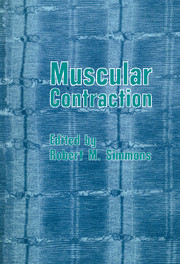Book contents
- Frontmatter
- Contents
- Dedication
- Contributors
- Preface
- 1 A. F. Huxley: an essay on his personality and his work on nerve physiology
- 2 A. F. Huxley's research on muscle
- 3 Ultraslow, slow, intermediate, and fast inactivation of human sodium channels
- 4 The structure of the triad: local stimulation experiments then and now
- 5 The calcium-induced calcium release mechanism in skeletal muscle and its modification by drugs
- 6 Hypodynamic tension changes in the frog heart
- 7 Regulation of contractile proteins in heart muscle
- 8 Differential activation of myofibrils during fatigue in twitch skeletal muscle fibres of the frog
- 9 High-speed digital imaging microscopy of isolated muscle cells
- 10 Inotropic mechanism of myocardium
- 11 Regulation of muscle contraction: dual role of calcium and cross-bridges.
- 12 Fibre types in Xenopus muscle and their functional properties.
- 13 An electron microscopist's role in experiments on isolated muscle fibres.
- 14 Structural changes accompanying mechanical events in muscle contraction.
- 15 Mechano-chemistry of negatively strained cross-bridges in skeletal muscle.
- 16 Force response in steady lengthening of active single muscle fibres.
- References
- Index
13 - An electron microscopist's role in experiments on isolated muscle fibres.
Published online by Cambridge University Press: 07 September 2010
- Frontmatter
- Contents
- Dedication
- Contributors
- Preface
- 1 A. F. Huxley: an essay on his personality and his work on nerve physiology
- 2 A. F. Huxley's research on muscle
- 3 Ultraslow, slow, intermediate, and fast inactivation of human sodium channels
- 4 The structure of the triad: local stimulation experiments then and now
- 5 The calcium-induced calcium release mechanism in skeletal muscle and its modification by drugs
- 6 Hypodynamic tension changes in the frog heart
- 7 Regulation of contractile proteins in heart muscle
- 8 Differential activation of myofibrils during fatigue in twitch skeletal muscle fibres of the frog
- 9 High-speed digital imaging microscopy of isolated muscle cells
- 10 Inotropic mechanism of myocardium
- 11 Regulation of muscle contraction: dual role of calcium and cross-bridges.
- 12 Fibre types in Xenopus muscle and their functional properties.
- 13 An electron microscopist's role in experiments on isolated muscle fibres.
- 14 Structural changes accompanying mechanical events in muscle contraction.
- 15 Mechano-chemistry of negatively strained cross-bridges in skeletal muscle.
- 16 Force response in steady lengthening of active single muscle fibres.
- References
- Index
Summary
Introduction
“Everything you see in the electron microscope is an artefact”! This truism does not mean that observations on denatured cells are a waste of time. The information has to be corroborated by other methods, preferably with observations on fresh tissues that are still able to perform their chemical and mechanical functions. When Andrew Huxley came to University College London 1960, he already had experience using electron miscroscopy (A. F. Huxley, 1959). I took charge of the Siemens EMI previously used by Hugh Huxley who was moving to Cambridge, and I used it for most of the work described in this review.
Andrew Huxley's insight into problems of light and electron microscopy was an enormous help to me. In his B.Sc. class, he demonstrated the role of diffraction in the formation of the light microscope image, using striated muscle as a grating and a moveable stop in the back lens of the objective. When I was using laser diffraction to measure the periodicities in electron micrographs, he insisted that I understand the errors that could occur (Brown, 1975a). His pursuit of accuracy was insatiable. We once spent six weeks trying to take a light micrograph of a crosshatched grating replica with oblique illumination. The spacing of 0.45 μm was within the limits of resolution but we were frustrated by the presence of lens aberrations (coma). He wasn't averse to buying expensive equipment when it was necessary, but found inexpensive solutions to many technical problems. Light micrographs were taken with the camera suspended over the microscope. When both were focussed at infinity, all problems with vibration and stray light were avoided.
- Type
- Chapter
- Information
- Muscular Contraction , pp. 189 - 202Publisher: Cambridge University PressPrint publication year: 1992
- 1
- Cited by



